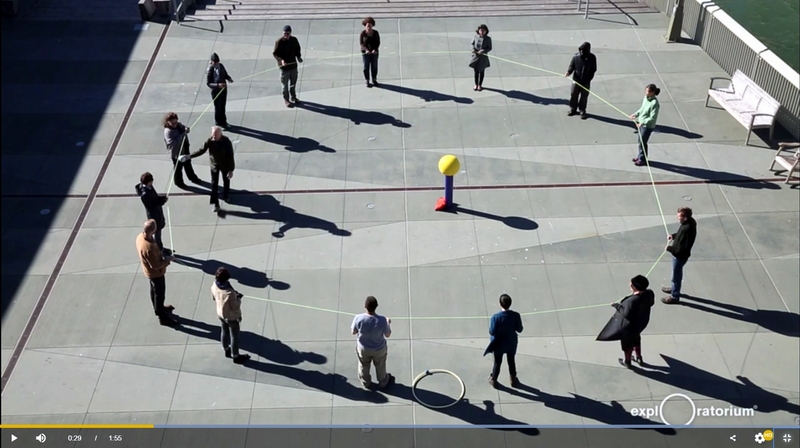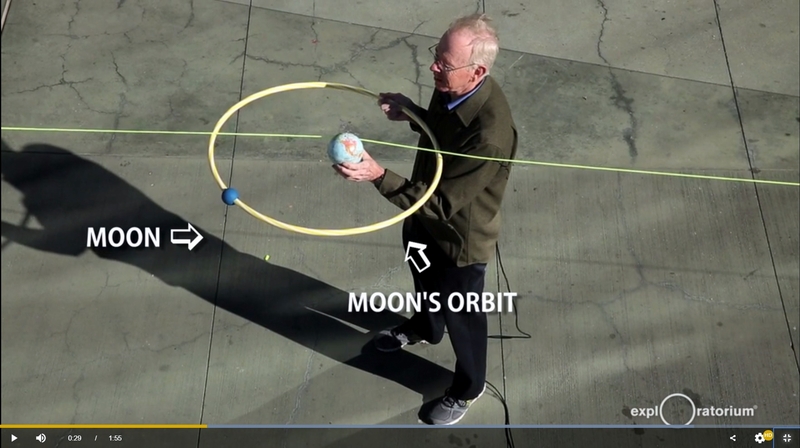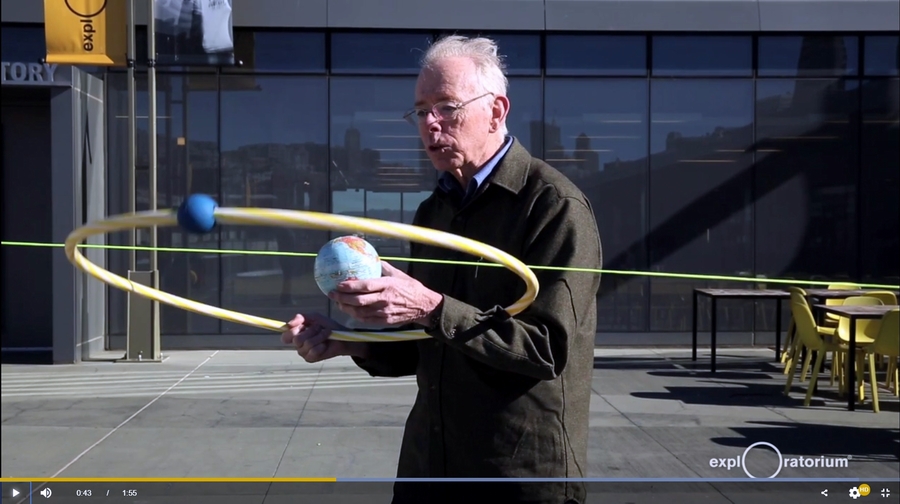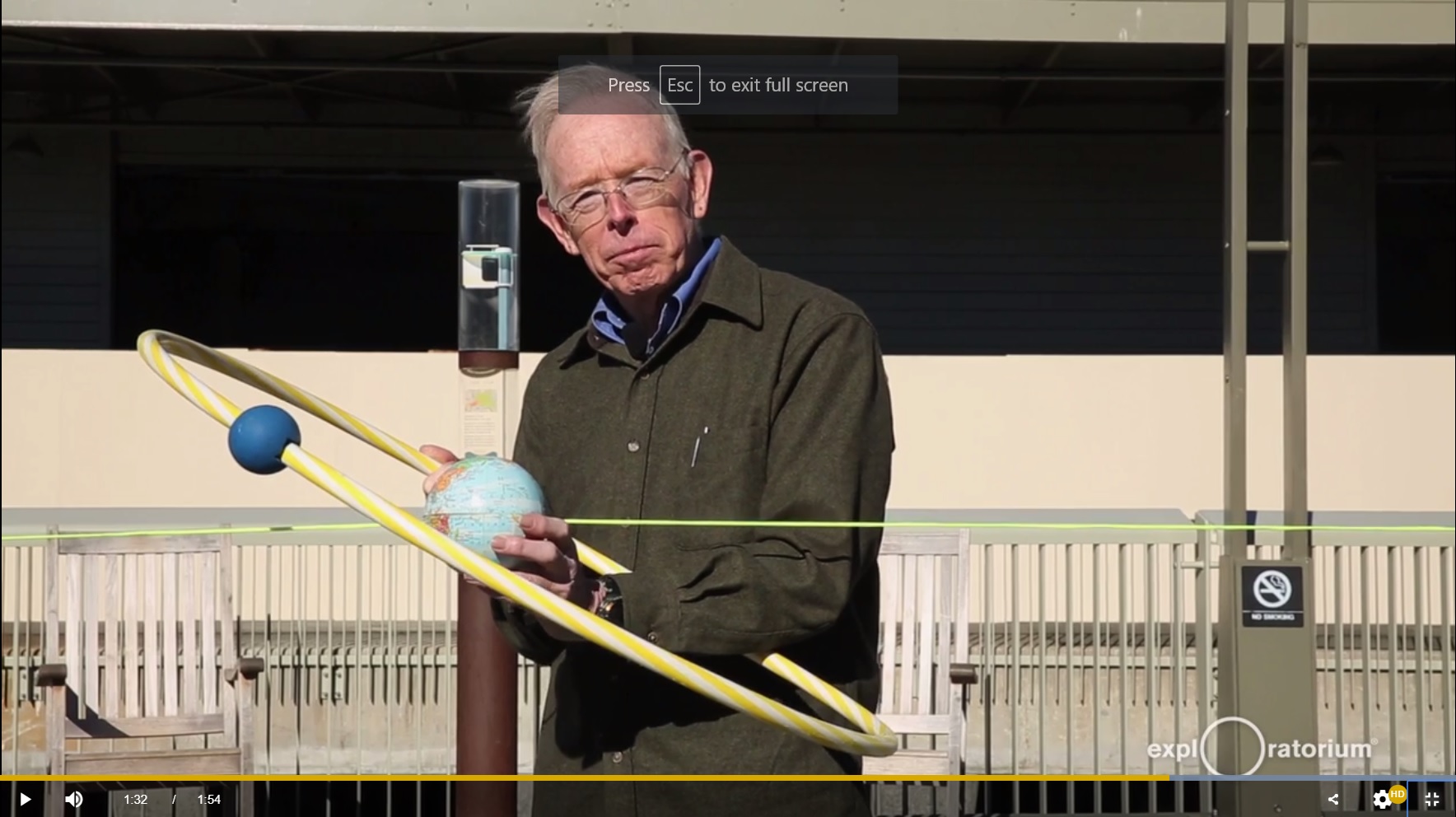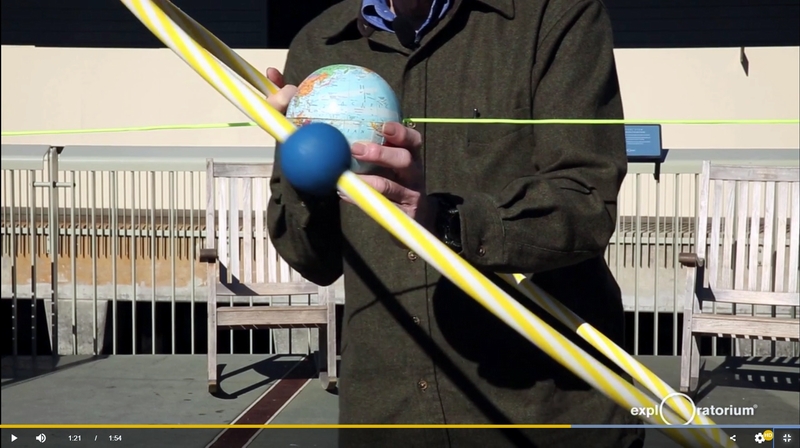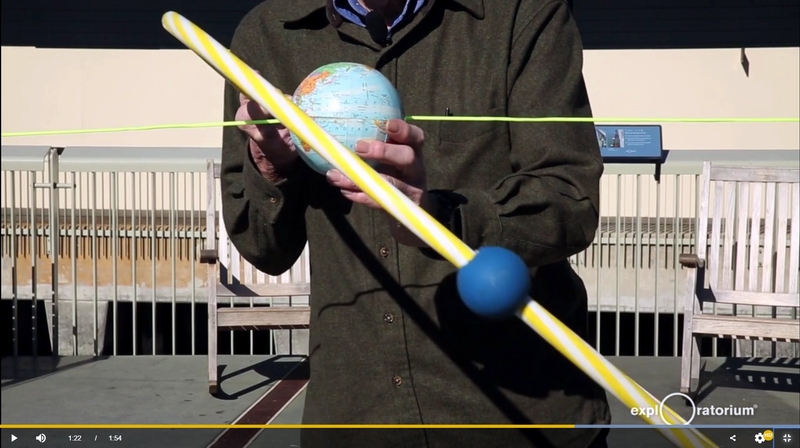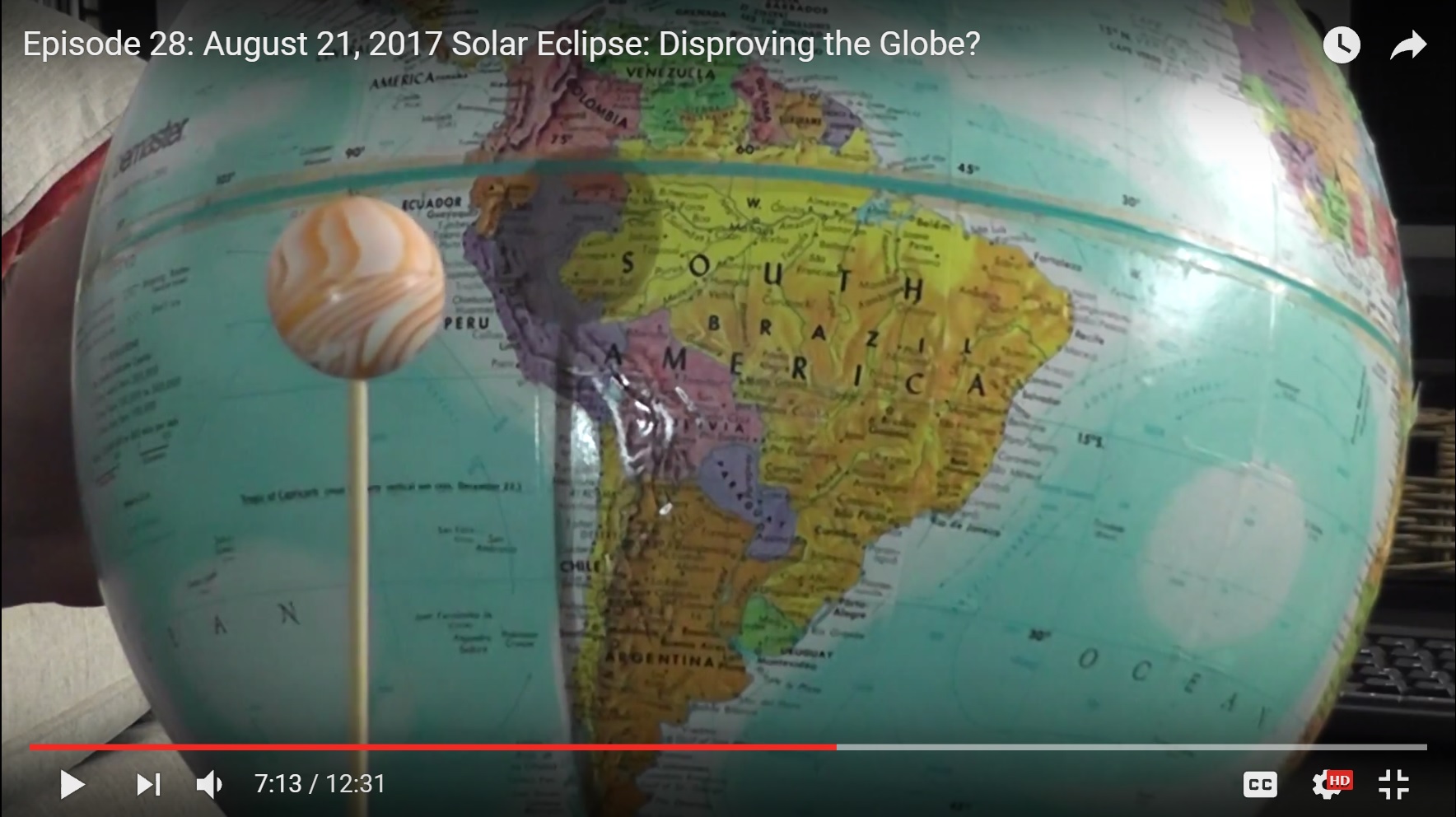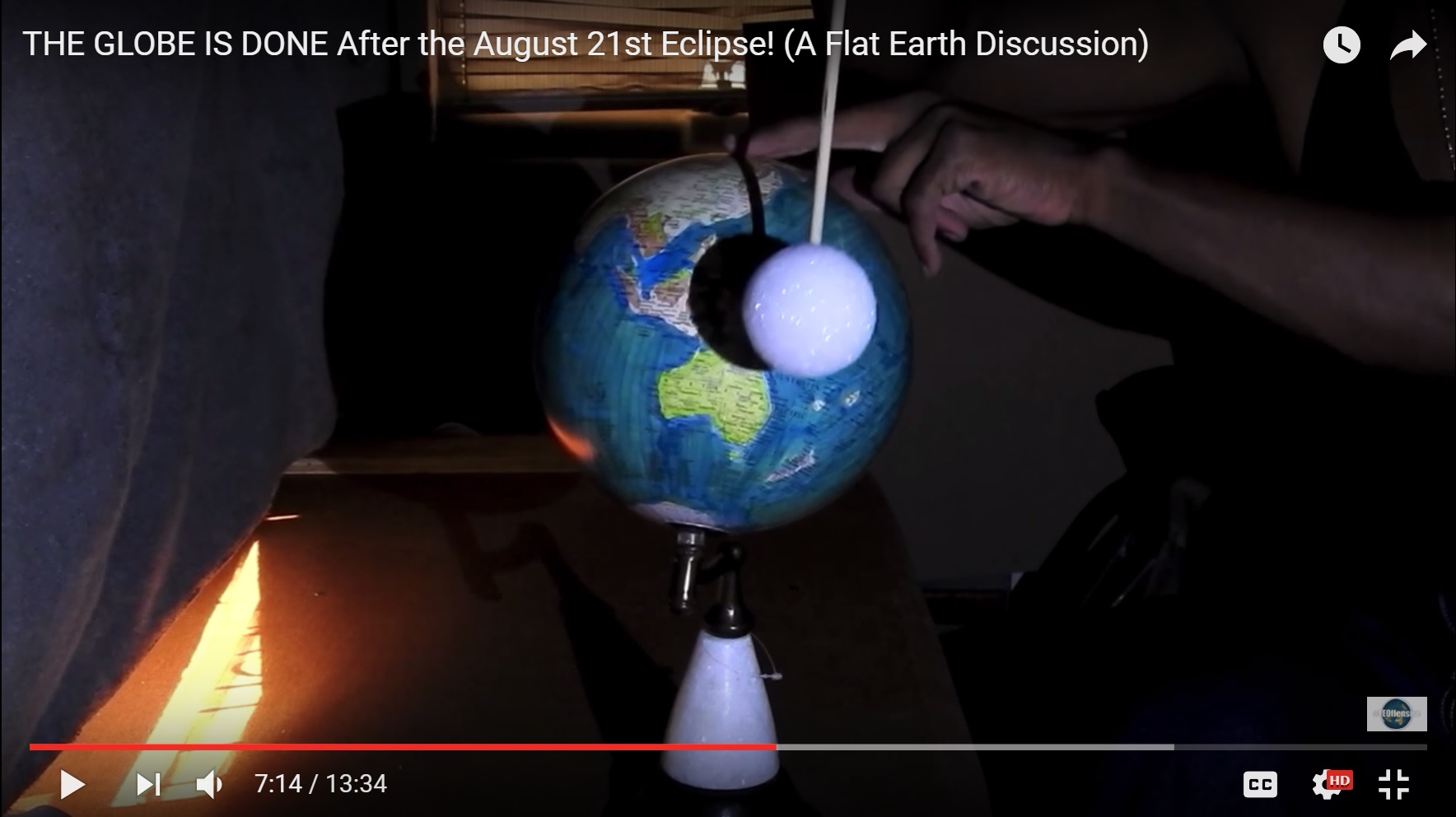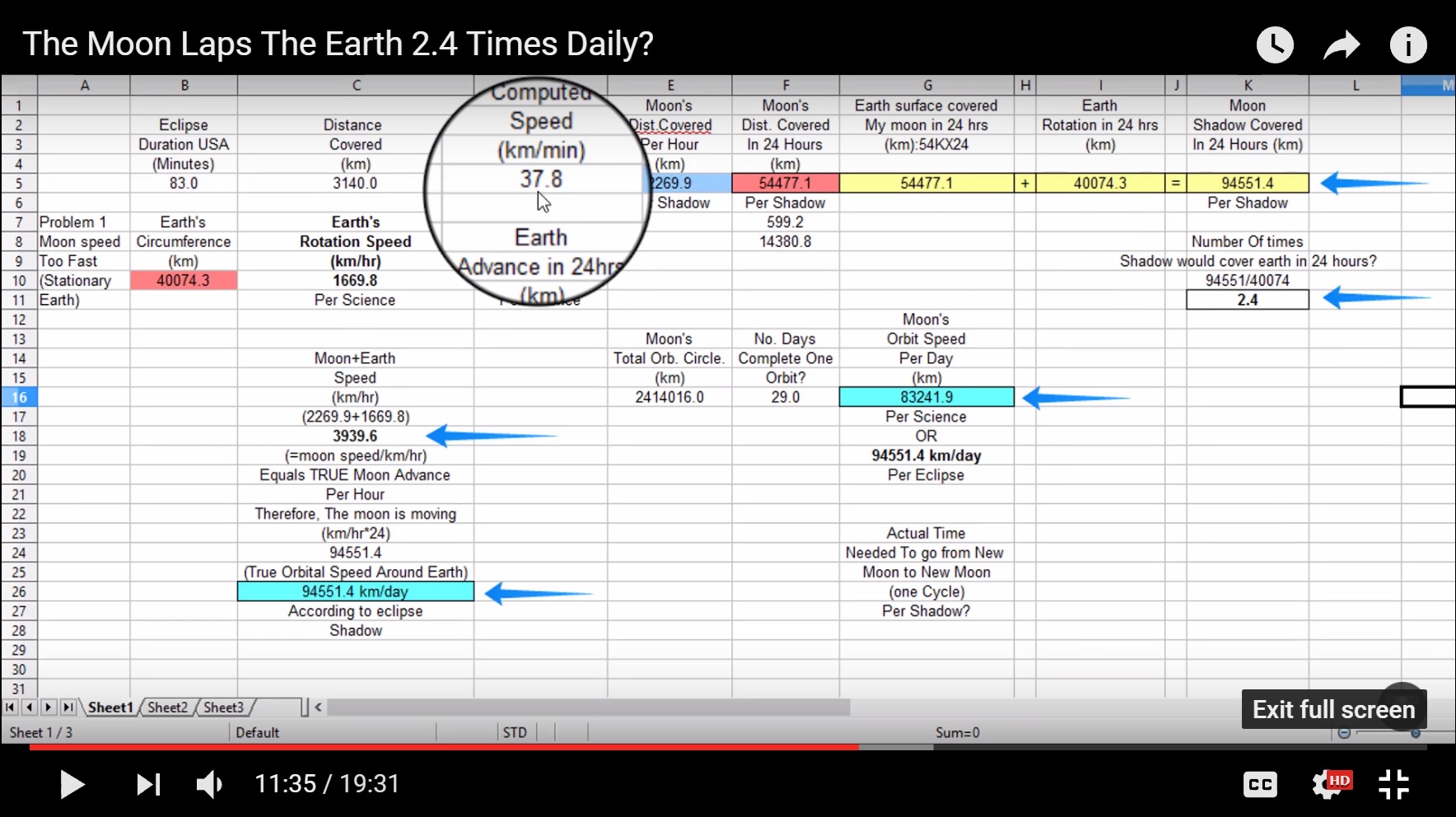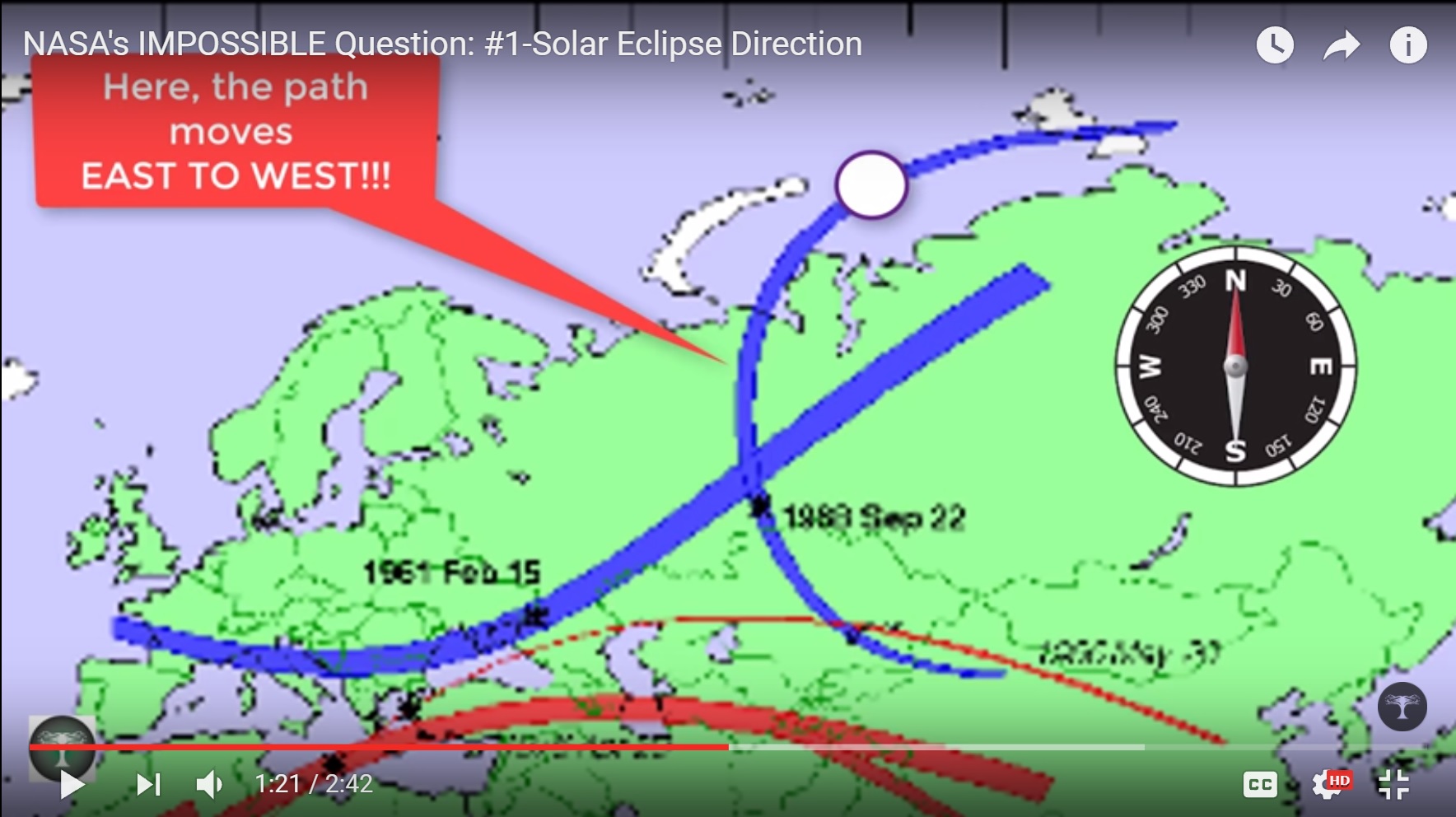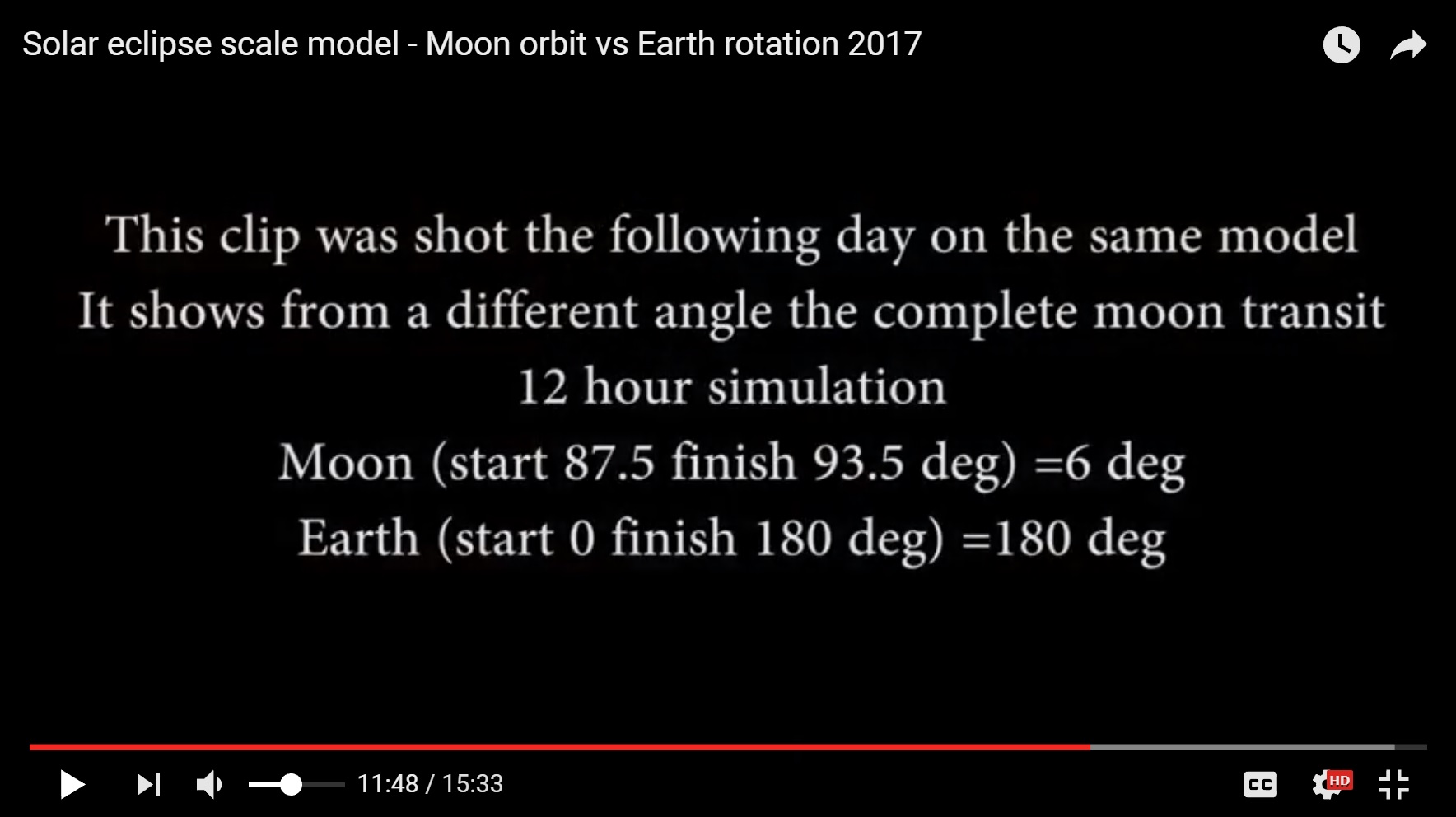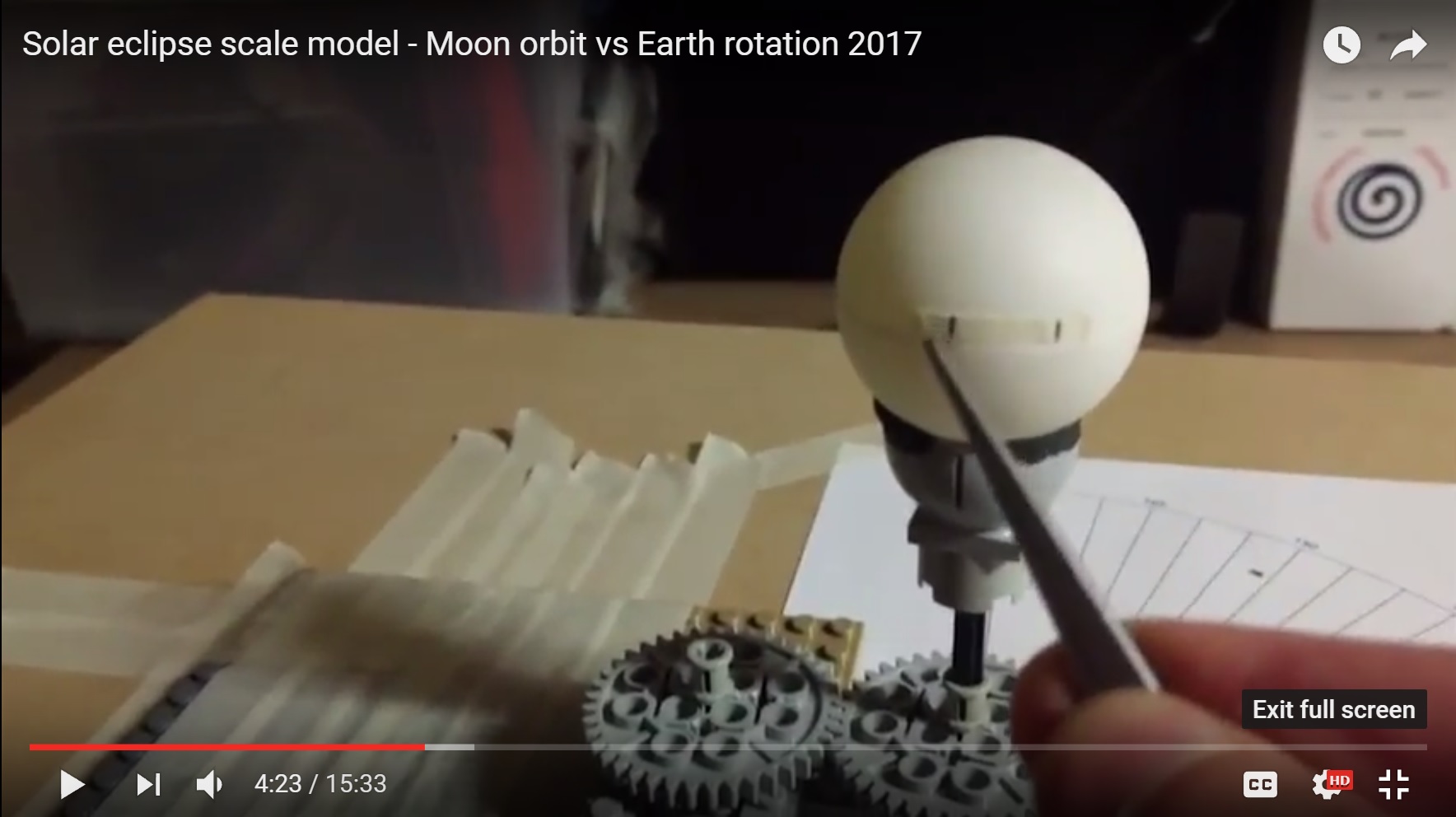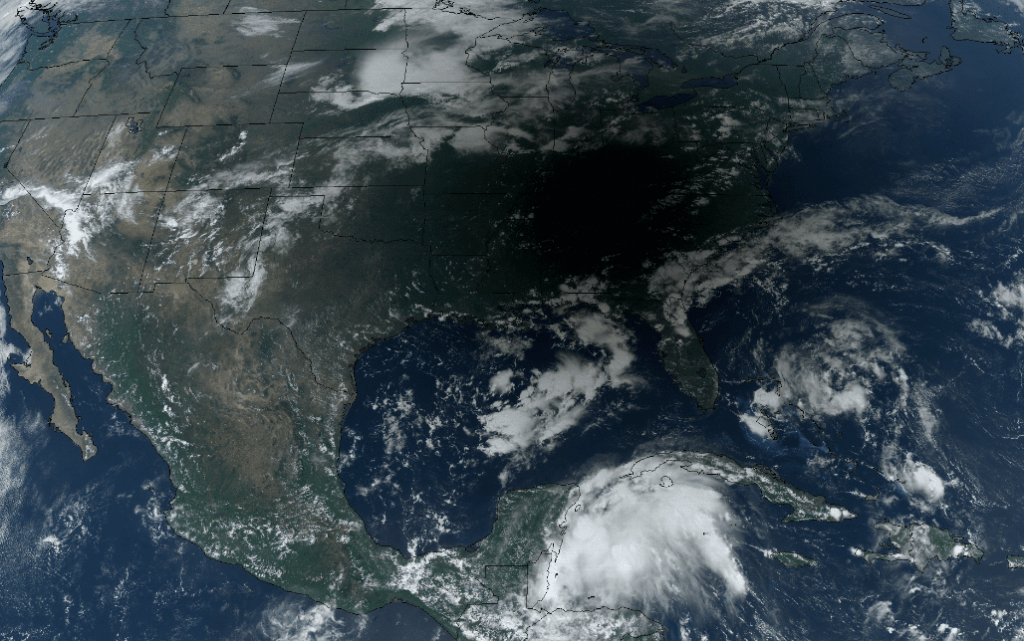Z.W. Wolf
Senior Member.
The earth rotates around its own axis eastward. Or put another way, as viewed from the north star Polaris, the earth turns counterclockwise. Because of this we see the moon travel across our sky from east to west during the day.
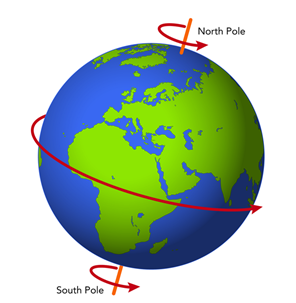
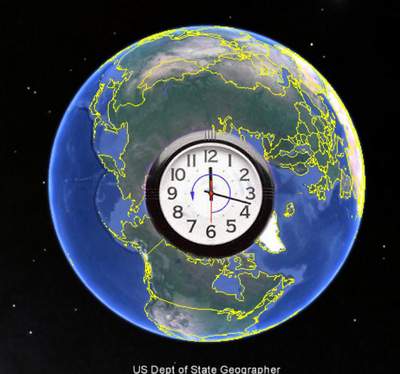
But during the upcoming solar eclipse the moon's shadow will travel across the US from west to east. At first this seems to make no sense. It's a complicated problem. But it can be resolved and understood if two things are kept in mind:
-You must use a scale model with proper motions.
-You have to understand that the moon's shadow moves across the earth, not around the earth.
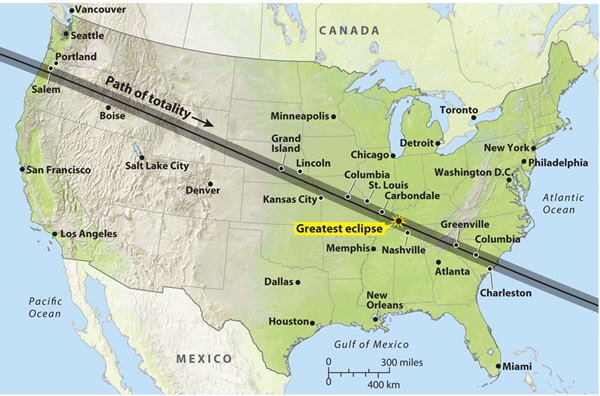
The moon orbits the earth, as viewed from Polaris, in a counterclockwise motion. Therefore the shadow cast by the moon travels across the earth's surface from west to east as it outpaces the relatively slower rotation of the earth.
This GIF from a superb video made by "DelBoy 1967" will illustrate:
DelBoy 1967 constructed a scale model and used carefully calculated motions. This produced both an accurate and a clearly understandable illustration of the situation. Note that the model "earth" is rotating and if you look carefully you'll see marks on the surface which represent the distance between the west coast and the east coast of the U.S. It's important to understand that although it looks as if the "moon" is moving in a linear (side to side) motion, it is actually following a curved path. It is following an arc of the moon's orbit.
The problem as alleged by various FE believers: The moon's shadow will cross the entire USA in just a few hours. Therefore, if the official explanation were true the moon's shadow would circle the entire earth in just a few hours or days - (time estimates vary). But we are told that the moon completes one orbit in 27.32 days (if they cite the sidereal lunar month); or 29.5 days (if they cite the moon phase cycle).
Their claim: This is a fatal paradox for the heliocentric and sphere earth model. The moon is said to travel around the earth at different rates. When "Science" explains the lunar month, the moon is said to take 29 days to go around the earth. But as "Science" explains the solar eclipse, it follows logically that the moon would have to travel around the earth in just a few days! (And "Science" hasn't even noticed that this is a paradox. We've caught them!)
Further explanation: The FE believers are noting the number of hours it will take for the moon's shadow to cross the (approximately) three thousand miles of the USA. They then attempt to calculate an average speed in miles per hour. Or they might rely on the ballpark figure of 1,100 mph you'll see here and there on the Net. Then they attempt to calculate how many hours it would take the moon's shadow to cross the entire 25,000 miles of the earth's circumference. Calculations and claims vary. Because of that - and also because the videos and so on in which these claims are being put forth are typically long and rambling - I'm not going to point to any one source. It will be easy to find a large number if you're curious. I'm just putting forth a quick summary of the core claim.
They are also troubled about the seeming paradox of two different motions of the moon. East to west in our sky, and west to east during the eclipse.
[Edit: On reconsideration I have to make this further caveat. There are so many variations on the argument that it's hard to put them in all in one box. There is one feature they all share: they get into trouble when they don't use a properly scaled visual illustration of the heliocentric model. I'm going to make an additional post to cover this issue and give some examples.]
Solution to the paradox: The FE believers have made a mistake about the motion of the moon's shadow. The moon's shadow is not circling around the surface of the earth. The moon's shadow is moving across a portion of the earth's surface. They seemingly haven't considered the fact that the sun isn't conveniently following the moon around to cast that shadow.
An illustration to help picture what the situation is...
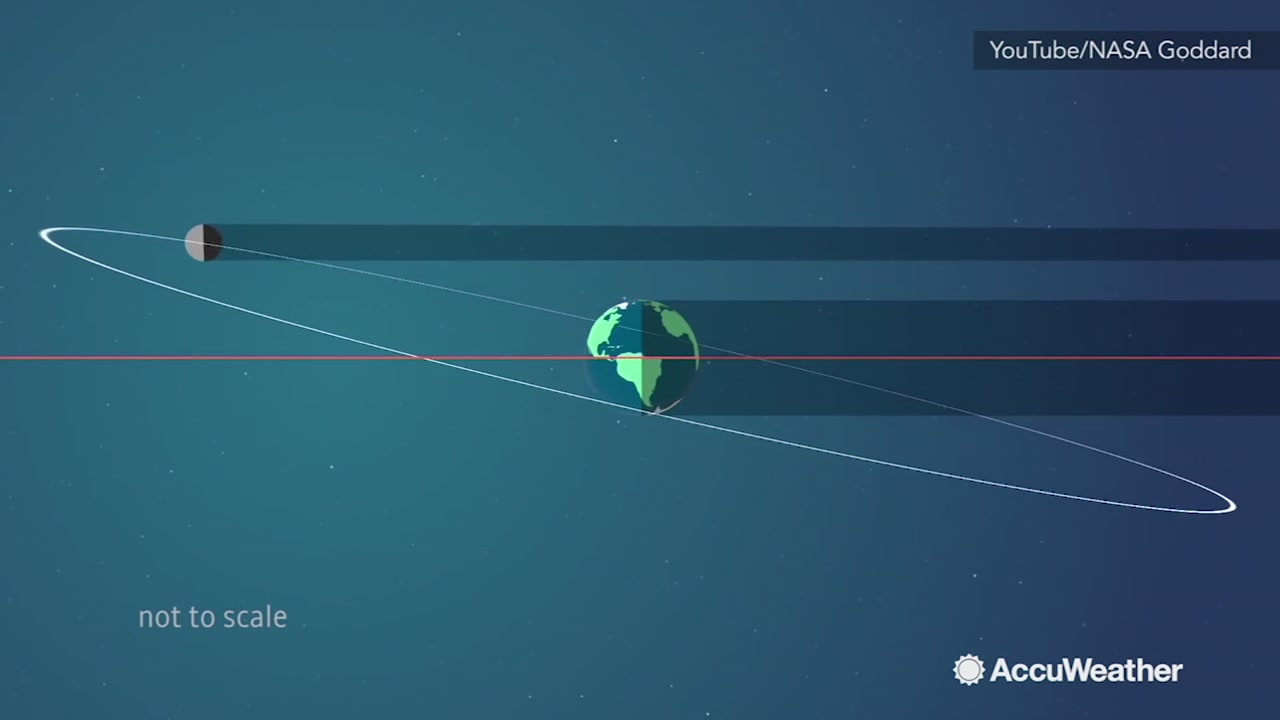
In this (not to scale!) side view, the sun is to the left. The moon's shadow is not hitting the earth. The moon's shadow is stretching out across space. This will also begin to show why solar eclipses are rare. Because the moon's orbit is tilted to the plane of the ecliptic (red line) the sun, moon, and earth seldom line up exactly. Almost all the time the moon's shadow is stretching out across empty space.
I'm mentioning this point because it's part and parcel of the main issue: How the moon's shadow travels both across space and the surface of the earth.
For a more detailed explanation, we'll go to this site:
https://www.exploratorium.edu/eclipse/video/why-dont-we-have-an-eclipse-every-month
Note that the camera is looking at the model earth and moon from the position of the model sun. It should be clear that the moon's shadow is not moving around the earth. It's moving across the earth. Note that the moon's shadow would now be on his coat.
It should also be clear that as the moon moves in its counterclockwise orbit, the moon's shadow is moving across the earth from west to east.
The moon's shadow is moving across the face of the earth so fast that it outpaces the rotation of the earth. In other words the shadow is moving from west to east faster than the moon is moving in our sky from east to west.
But don't try to add up the number of hours it takes to move across the three thousand miles of the USA and then calculate how many hours it would take to circle the earth. That is the fatal mistake FE believers are making.
Dr. Doherty's little model is not to scale. But this top view illustration is to scale. The little dot at the top is the moon.
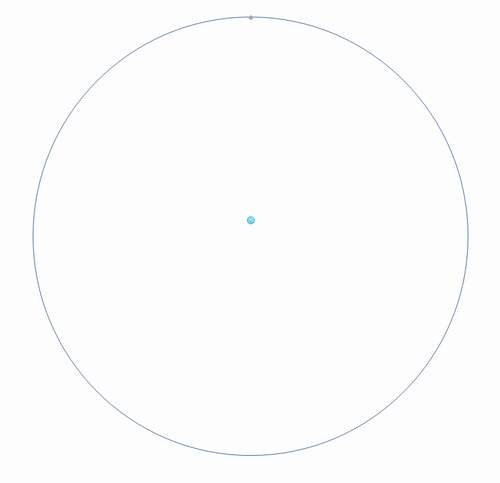
In this 2-D illustration of the upcoming solar eclipse we have to imagine that the moon is in just the proper position to cause a solar eclipse. The moon is not only between the sun and the earth, but the moon is also on the plane of earth's orbit as explained above. We are looking down at the north pole of the earth. East on the earth is to the left and west is on the right. The sun is off screen directly above. The red arrow represents the direction of the moon's shadow.
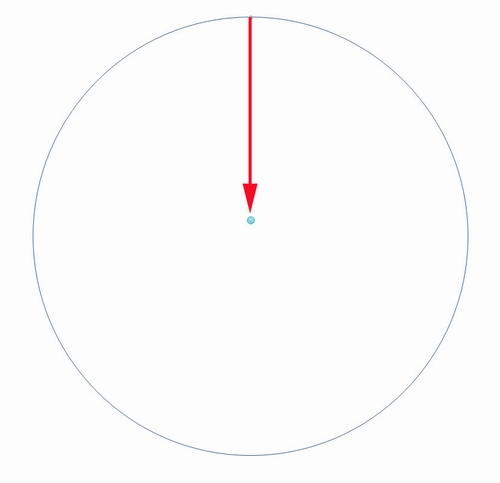
Because the sun is at the top of the illustration, the sun's rays are going to continue to shine from top to bottom during the lunar month. (Yes, the earth and moon will continue on their orbit around the sun during the lunar month so there will be some movement.)
This little GIF shows the the direction of the moon's shadow during this lunar month. It will move across the earth's surface on August 21. Not around the earth's surface. Most of the time, the moon will be casting its shadow across empty space. There's only a brief few hours that it will hit the earth.
Okay, that's the basic explanation of the problem with the FE believer's paradox idea. But the speed of the moon in its orbit is just one factor that explains the west to east movement and the varying speed at which the moon's umbra moves across the surface of the earth.
To be thorough, one must also factor in the 3-D shape of the earth and how it affects the movement of the moon's shadow across the curved surface of the earth. A picture is worth a thousand words...
This may look wrong at first sight, and it would be if the earth's surface were flat. But you have to factor in the curved surface of the earth.
And it's important to note that the camera is NOT fixed relative to the sun. It's fixed relative to a spot on the far side of the moon. If we turned the camera around, we would see the sun slowly moving across the screen as the moon moves in its orbit. So this could be a bit deceptive.
And that's where I'll have to leave you because this is going past my ability to explain more fully.


But during the upcoming solar eclipse the moon's shadow will travel across the US from west to east. At first this seems to make no sense. It's a complicated problem. But it can be resolved and understood if two things are kept in mind:
-You must use a scale model with proper motions.
-You have to understand that the moon's shadow moves across the earth, not around the earth.

The moon orbits the earth, as viewed from Polaris, in a counterclockwise motion. Therefore the shadow cast by the moon travels across the earth's surface from west to east as it outpaces the relatively slower rotation of the earth.
This GIF from a superb video made by "DelBoy 1967" will illustrate:
DelBoy 1967 constructed a scale model and used carefully calculated motions. This produced both an accurate and a clearly understandable illustration of the situation. Note that the model "earth" is rotating and if you look carefully you'll see marks on the surface which represent the distance between the west coast and the east coast of the U.S. It's important to understand that although it looks as if the "moon" is moving in a linear (side to side) motion, it is actually following a curved path. It is following an arc of the moon's orbit.
The problem as alleged by various FE believers: The moon's shadow will cross the entire USA in just a few hours. Therefore, if the official explanation were true the moon's shadow would circle the entire earth in just a few hours or days - (time estimates vary). But we are told that the moon completes one orbit in 27.32 days (if they cite the sidereal lunar month); or 29.5 days (if they cite the moon phase cycle).
Their claim: This is a fatal paradox for the heliocentric and sphere earth model. The moon is said to travel around the earth at different rates. When "Science" explains the lunar month, the moon is said to take 29 days to go around the earth. But as "Science" explains the solar eclipse, it follows logically that the moon would have to travel around the earth in just a few days! (And "Science" hasn't even noticed that this is a paradox. We've caught them!)
Further explanation: The FE believers are noting the number of hours it will take for the moon's shadow to cross the (approximately) three thousand miles of the USA. They then attempt to calculate an average speed in miles per hour. Or they might rely on the ballpark figure of 1,100 mph you'll see here and there on the Net. Then they attempt to calculate how many hours it would take the moon's shadow to cross the entire 25,000 miles of the earth's circumference. Calculations and claims vary. Because of that - and also because the videos and so on in which these claims are being put forth are typically long and rambling - I'm not going to point to any one source. It will be easy to find a large number if you're curious. I'm just putting forth a quick summary of the core claim.
They are also troubled about the seeming paradox of two different motions of the moon. East to west in our sky, and west to east during the eclipse.
[Edit: On reconsideration I have to make this further caveat. There are so many variations on the argument that it's hard to put them in all in one box. There is one feature they all share: they get into trouble when they don't use a properly scaled visual illustration of the heliocentric model. I'm going to make an additional post to cover this issue and give some examples.]
Solution to the paradox: The FE believers have made a mistake about the motion of the moon's shadow. The moon's shadow is not circling around the surface of the earth. The moon's shadow is moving across a portion of the earth's surface. They seemingly haven't considered the fact that the sun isn't conveniently following the moon around to cast that shadow.
An illustration to help picture what the situation is...

In this (not to scale!) side view, the sun is to the left. The moon's shadow is not hitting the earth. The moon's shadow is stretching out across space. This will also begin to show why solar eclipses are rare. Because the moon's orbit is tilted to the plane of the ecliptic (red line) the sun, moon, and earth seldom line up exactly. Almost all the time the moon's shadow is stretching out across empty space.
I'm mentioning this point because it's part and parcel of the main issue: How the moon's shadow travels both across space and the surface of the earth.
For a more detailed explanation, we'll go to this site:
https://www.exploratorium.edu/eclipse/video/why-dont-we-have-an-eclipse-every-month
Exploratorium Senior Scientist Paul Doherty explains why we don't have a solar eclipse every month—the orbit of the moon is tilted relative to the orbit of the Earth around the sun, so the moon often passes below or above Earth. At those times, it does not cross the line between the sun and the Earth, and therefore does not create a solar eclipse. There are just two times a year in the Earth's orbit when there is a possibility of a total solar eclipse.
"The yellow string represents the plane of the earth's orbit around the sun. The plane of the ecliptic."
"The hula hoop represents the plane of the moon's orbit around the earth."
"The moon's orbit is tilted." [There will be no solar eclipse during a lunar month when the moon's orbit is tilted in this way relative to the sun and earth. The moon's shadow will miss the earth during the entire lunar month and stretch out across empty space.]
"We've moved around three months, a quarter of the way around the earth's orbit. The moon's orbit is still tilted, but in exactly the same angle as before. The moon's orbit acts like a gyroscope as the earth moves around the sun."
"Now as the moon comes around, it crosses the plane of the earth's orbit. It gets between the earth and the sun, and now it can cast a shadow across the earth and make an eclipse."
[And the moon continues on in its orbit and the eclipse is over.]
Note that the camera is looking at the model earth and moon from the position of the model sun. It should be clear that the moon's shadow is not moving around the earth. It's moving across the earth. Note that the moon's shadow would now be on his coat.
It should also be clear that as the moon moves in its counterclockwise orbit, the moon's shadow is moving across the earth from west to east.
The moon's shadow is moving across the face of the earth so fast that it outpaces the rotation of the earth. In other words the shadow is moving from west to east faster than the moon is moving in our sky from east to west.
But don't try to add up the number of hours it takes to move across the three thousand miles of the USA and then calculate how many hours it would take to circle the earth. That is the fatal mistake FE believers are making.
Dr. Doherty's little model is not to scale. But this top view illustration is to scale. The little dot at the top is the moon.

In this 2-D illustration of the upcoming solar eclipse we have to imagine that the moon is in just the proper position to cause a solar eclipse. The moon is not only between the sun and the earth, but the moon is also on the plane of earth's orbit as explained above. We are looking down at the north pole of the earth. East on the earth is to the left and west is on the right. The sun is off screen directly above. The red arrow represents the direction of the moon's shadow.

Because the sun is at the top of the illustration, the sun's rays are going to continue to shine from top to bottom during the lunar month. (Yes, the earth and moon will continue on their orbit around the sun during the lunar month so there will be some movement.)
This little GIF shows the the direction of the moon's shadow during this lunar month. It will move across the earth's surface on August 21. Not around the earth's surface. Most of the time, the moon will be casting its shadow across empty space. There's only a brief few hours that it will hit the earth.
Okay, that's the basic explanation of the problem with the FE believer's paradox idea. But the speed of the moon in its orbit is just one factor that explains the west to east movement and the varying speed at which the moon's umbra moves across the surface of the earth.
To be thorough, one must also factor in the 3-D shape of the earth and how it affects the movement of the moon's shadow across the curved surface of the earth. A picture is worth a thousand words...
This may look wrong at first sight, and it would be if the earth's surface were flat. But you have to factor in the curved surface of the earth.
And it's important to note that the camera is NOT fixed relative to the sun. It's fixed relative to a spot on the far side of the moon. If we turned the camera around, we would see the sun slowly moving across the screen as the moon moves in its orbit. So this could be a bit deceptive.
And that's where I'll have to leave you because this is going past my ability to explain more fully.
Last edited:

